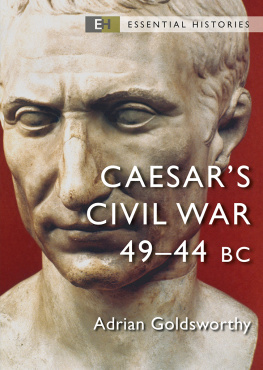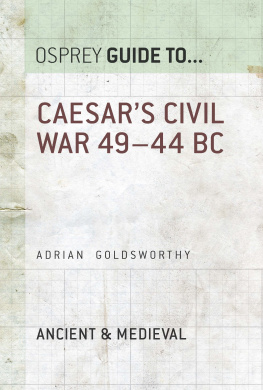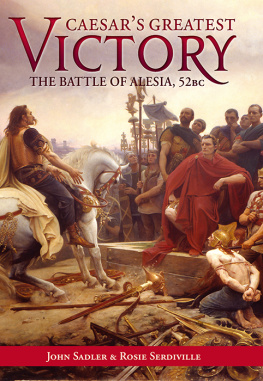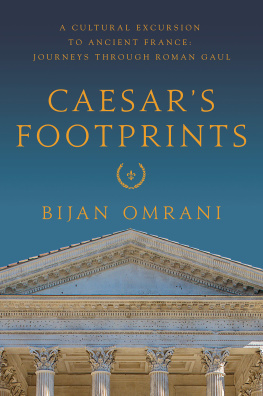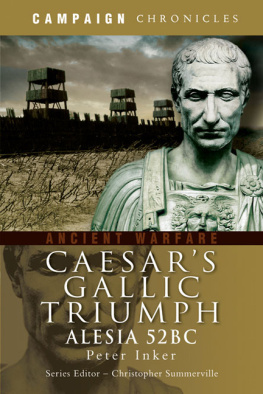Julius Caesars Battle for Gaul
New archaeological perspectives
edited by
Andrew P. Fitzpatrick
and Colin Haselgrove
List of figures and tables
Figures
: Map showing location of key sites mentioned in the volume.
Nineteenth-century statue of Arvernian chieftain Vercingetorix by Aim Millet, at Mont Auxois, Alise-Sainte-Reine, Cte-dOr.
Gold stater of Vercingetorix from the hoard discovered at Pionsat, Puy-de-Dme, in 1852.
Gaul: civitates and major regional subdivisions in the decades prior to the Gallic War.
Chronological phases identified for selected sites and areas of non- Mediterranean France and adjacent areas from c. 200 BC to the time of Augustus.
Plan of a late La Tne aristocratic farm at Batilly-en-Gtinais, Loiret.
Selected agricultural iron tools of the later Iron Age.
Plan of Mont Beuvray, Nivre/Sane-et-Loire.
Corent, Puy-de-Dme. Sanctuary within the oppidum, earlier 1st century BC.
Urville-Nacqueville, Manche. Inhumation burials and Kimmeridge shale bracelet rough-outs.
Four-sided, two-aisled structure, Ville Pollo, Trgueux, Ctes dArmor.
Corent, Puy-de-Dme. Warehouse with a long narrow cellar for the storage of wine amphorae.
Stages in the Roman conquest of Hispania.
Aerial view of the Roman Republican camp at Cceres el Viejo, Cceres.
Military sites of the Sertorian Wars.
Renieblas, Soria: plan of Camps IV.
The Roman camps at Renieblas from the air.
Plan of the Roman camp at Almazn, Soria.
The Roman Republican camp at Vila Joiosa, Alicante: the ditch during excavation.
Roman torsion catapult ( scorpio ) found at La Caridad de Caminreal, Teruel.
The coast of Alicante south of Cap de la Nau viewed from Punta de la Torre.
Aerial photograph of Penya de lguila, Alicante.
The small fort of Passet de Segria, Alicante.
Militaria and other finds from the small coastal forts in Alicante.
The two main routes for the migration of the Helvetii and associated tribes in 58 BC, from the Swiss Plateau to south-west France.
The limits given by Caesar for the territory of the Helvetii in 58 BC.
The Helvetii, their neighbours and the migration of Spring 58 BC.
The battle near Bibracte begins: the Helvetii attack the Roman legions arranged on the flank of the hill.
The harbour at Genava (Geneva) at the end of the 2nd or beginning of the 1st century BC.
28 March 58 BC: at Genava, Caesar has destroyed the bridge over the Rhne, between the Roman provincia and Helvetian territory.
Excavations in 1986 at Mont de Jaux, Montmort, Sane-et-Loire, substantial ditch of military appearance.
(A) The location of the oppida of Yverdon-les-Bains and Sermuz, Vaud. (B) Pfostenschlitzmauer at Mont Vully, Fribourg, and murus gallicus at Sermuz.
View from the Bois de Chtel looking towards Avenches, Vaud, and the oppidum of Mont Vully.
The names of prominent Helvetii known from texts and archaeology (coins).
Plan of Mauchamp, Aisne, from Napolon IIIs Histoire de Jules Csar.
Air photograph of Mauchamp.
Map of Celtic oppida and Roman siegeworks in the Limagne, Puy-de-Dme.
The Roman siegeworks between Gergovia and Gondole, Puy-de-Dme.
Types of weapons discovered around Gergovia.
Plan of Alesia, Cte-dOr, from Napolon IIIs Histoire de Jules Csar.
Air photograph of Alesia, from the west.
Excavations at the foot of Mont Ra, March 1863.
(1) Sling bullet with the name of T.LABI(enus) from Camp C; (2) Lilia with a Roman spearhead at the foot of Mont Ra; (3) Cippi of the circumvallation near Camp C.
German excavations (RGK) in the Plaine des Laumes.
Reconstruction of the contravallation in the Plaine des Laumes.
Types of Roman defences at Alesia.
The Roman siegeworks at Uxellodunum, Lot, from Napolon IIIs Histoire de Jules Csar.
Arrowheads discovered at Uxellodunum.
Thuin, Belgium: topography of the late Iron Age fortification and the location of gold hoards and clusters of Roman lead sling bullets.
Geographical reconstruction of Caesars Germanic campaign of 55 BC.
Hypothetical scenario of the Roman attack on the Germanic camp.
The modern topography of the Kessel/Lith area, Netherlands, showing the actual courses of the Meuse and Waal rivers and the main find concentrations in fossil Meuse channel.
Chronological ordering of 42 radiocarbon-dated human bones dredged from the Meuse at Kessel/Lith.
Radiocarbon dates from Kessel/Lith and the Caesarian camp at Hermeskeil.
Radiocarbon-dated human bones with traces of trauma from the Meuse at Kessel/Lith.
La Tne D2 swords and scabbard plates found in an ancient bed of the Meuse at Kessel-Lith.
Roman military equipment dredged up at Kessel/Lith, including late Iron Age iron helmet of Port type.
Tribal map of the Germanic frontier zone in the Caesarian period and the Augustan/Tiberian period.
Test regions with high-quality settlement evidence.
Reconstructed demographic fluctuations in various French regions during thelater Iron Age.
Model of a Roman galley of the 1st century BC or AD.
The location of coastal places in Kent and Pas-de-Calais.
View looking south towards the northern end of the cliffs of Dover at Kingsdown.
View to the north from the same position on Walmer beach.
View to the west from the foot of the beach face at Walmer at low tide.
Aerial view of the Ebbsfleet enclosure.
Plan of the Ebbsfleet enclosure.
Lidar model of north-east Kent, showing the location of selected places mentioned in the text.
View of Pegwell Bay from Cliffs End, looking south.
Looking north towards the cliffs at Cliffs End and Ramsgate.
(A) Map of the Centre-Val de Loire region, France. (B) Map of the territory of the Bituriges and modern Berry.
The main movements of Caesar and Vercingetorix between February and April 52 BC.
Neung-sur-Beuvron, Loir-et-Cher: plan of the oppidum (Noviodunum biturigum) and potential territory or pagus .
Gorgobina: location of the Montagne de Sancerre and the agglomeration of Saint-Satur, Cher.
Bourges-Avaricum, Cher: sketch plans of the oppidum and the Gaulish fortifications and supposed location of Caesars siege installations.
The reconstructed murus gallicus at Bibracte, Mont-Beuvray, Nivre/Sane-et-Loire.
Bourges, ditch at the top of rue Moyenne, 1987 excavations.
Map of massive dump ramparts in France.
Rampart and ditch at Chteaumeillant, Cher.
3D reconstruction of the fortifications at the oppidum of Chteaumeillant.
The massive dump rampart at Chteaumeillant.
Giubiasco Grave 108, Tessin, Switzerland.
Map of the areas examined in the study of Gallic auxiliaries in the 2nd and 1st centuries BC.
Selection method for the graves used in the study of auxiliaries in the 2nd and 1st centuries BC.
Late Iron Age weapons of the Celtic tradition.
Late Iron Age weapons of the Roman and Germanic traditions.
Location of the sites analysed.
Chronological distribution of weapon graves between c. 20030 BC in the Nmes region.
Weaponry and spurs from funerary chamber A at Goeblingen-Nospelt, Luxembourg.
Swords in their scabbards from the chamber grave at Flr-la-Rivire, Indre.
Burial period of selected graves containing weapons from central France.
Roman Republican iron catapult bolts and hobnails from the oppidum of Sermuz, Vaud, Switzerland.
Map of the archaeological sites mentioned in the text and the course of the Iron Age road connecting the Roman military camp at Hermeskeil and the Hunnenring oppidum, Rheinland-Pfalz.


